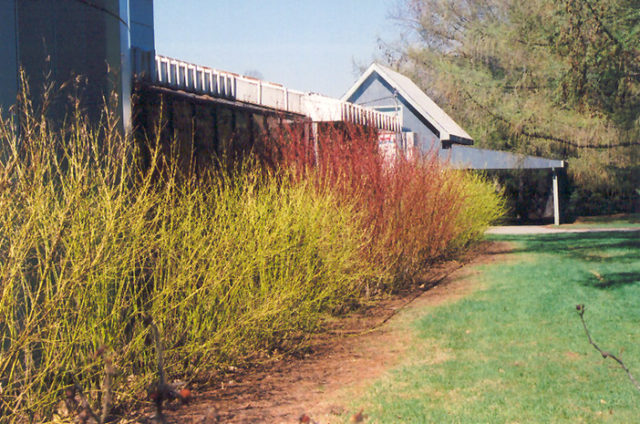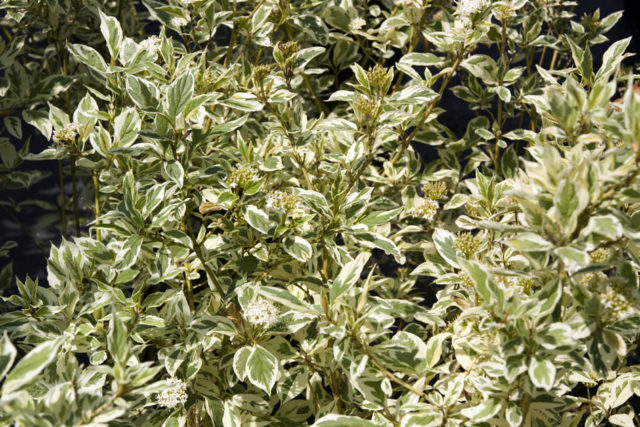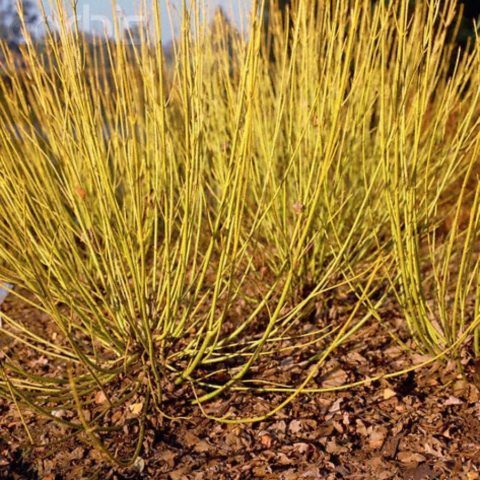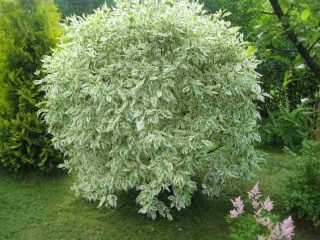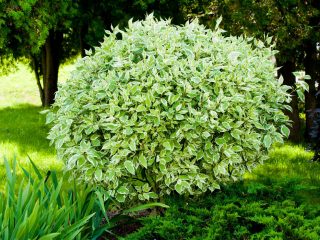Content
Sprout grass is a wonderful ornamental shrub that can decorate a garden plot throughout the year. Plant care is simple, the species is almost not affected by pests and diseases. It multiplies quickly and grows after pruning.
Description of sucker tree
The shrub grows naturally in North America. The plant is from 1.8 to 2.8 m high, the crown diameter is 2-3.5 m. The root system of the sucker tree is powerful, shoots are developed, which are located shallow from the soil surface. The peculiarity of the species is the production of a large number of root suckers, due to which the shrub captures new territories. The branches of the scion tree that droop to the very soil also take root easily. Depending on the variety, flexible shoots with shiny bark of different colors, from red-brown to yellow and light green.
The leaves of the scion tree are oval, with a sharp tip, large, up to 10-12 cm long, oppositely located. There are variegated varieties that turn yellow or reddish in the fall. The buds are formed on 5-6 year old plants, collected in corymbose inflorescences, the petals are small, white or cream in color.They bloom in late May or early June. From the second ten days of August, the berries ripen - white or lilac-blue inedible drupes.
The offspring dogwood is moisture-loving and shade-tolerant. Frost resistance is average - tolerates temperatures of 22-29 °C, taking into account air humidity and protection from cold winds. The best location is light partial shade.
It is recommended to trim the bushes heavily every few years, to 10 cm above the ground. The branches grow quickly and delight with the richness of colors.
Varieties
Through the efforts of breeders, several picturesque garden varieties have been developed based on the scion tree, which are distributed in the temperate climates of Europe and Asia.
Sprouting dogwood Flaviramea
A well-known variety among representatives of this species is the scion tree Cornus stolonifera Flaviramea. Valued for its picturesque shoots in the cold season. Bright, yellow-green, with shades of olive, the bark of the Flaviramea tree, as seen in the photo, adds a note of joy to the gloomy landscape. The bush is vigorously growing, rising up to 2-3 m. Erect branches form a rounded crown, up to 2.5 m in diameter. The leaves are opposite, oval, with a pointed tip, light green. Inconspicuous white-yellow inflorescences with a diameter of 4-5 cm. From afar, during flowering, the bush is illuminated.
According to the description, the Flaviramea turf grows 20 cm per season. The plant is persistent, develops in the shade, is at the same time drought-resistant, and can be planted in the sun, providing regular watering.
Kelsey shoot grass
The low variety of scion Kelsey grows up to 50-80 cm. Branches with green-yellow bark form a hemispherical crown.The tops of the branches and young shoots are reddish in color and retain this feature in winter. The oval leaves are bright green, with burgundy-red colors at the tops. In autumn they turn yellow-purple. Kelsey sprouting dera bushes are light-loving; they are placed in illuminated areas; light partial shade is allowed. The plant does not tolerate drought well. The soil is constantly moistened.
Sprouting dogwood White gold
A vigorously growing bush of the White Gold derena, which spreads up to 3 m in height and width. Olive-colored shoots form a rounded crown, which is easy to trim and quickly recovers. During the season, the shoots grow by 20 cm. The lanceolate green leaves are slightly pubescent below, wide, 7-8 cm long. The edges are edged with cream stripes. Small flowers with white petals bloom in May and June. In autumn the foliage is yellow.
Dera bushes of the offspring variety White Gold tolerate urban smoke, are resistant to winds, and require regular soil moisture. Young shoots may suffer in bright sun; it is better to plant them in partial shade.
Sprouting dogwood Nitida
A variety with tall, thick stems that rise up to 2-3 m. The bark of young shoots is bright green, rivaling in brightness the oval leaves, pointed towards the top. The leaf blade has expressive graphics of veins. The bush is easy to shape and prefers partial shade for development. Tolerates short-term flooding, like all varieties of sprouting tree.
Derain offspring Cardinal
The height of the shoots of the variety is moderate, from 1 to 1.2-1.7 m. A feature of the Cardinal cultivar is the variability of the color of the bark on the branches. In summer, the bark on the erect, slightly lodging shoots of this scion variety is olive-yellow; by autumn it becomes bright red.The crown is round, spreading, up to 1.5-1.8 m wide. The leaves are green and turn yellow and red as the temperature drops. Umbrella-shaped inflorescences up to 4-5 cm in diameter bloom throughout the summer, abundantly in late spring. The culture develops well in moist, fertile soils with a slightly acidic reaction and is not afraid of flooding. Cardinal bushes are often planted near bodies of water.
Derain offspring Insanti
The Isanti variety is quite short, the shoots grow up to 1-1.5 m. The bark of young branches is bright red and retains its color throughout the season. The interlacing shoots of the Isanti bush create a picturesque picture against the backdrop of snow. The leaves are dark green, turning red-purple in August. Small white inflorescences create a cute calico pattern against the background of foliage in May and June.
This fact is taken into account when planning the placement of a bush in the garden relative to the viewpoint.
Planting and care
Dera bushes prefer fertile, moist, including poorly drained soils with neutral acidity. Peat or sand is added to clayey ones. Sandy soils are not suitable for the crop because they do not retain water. The best site is with light partial shade. Derens easily take root along the banks of streams, on marshy soils, where willows and alders grow. Avoid hot and dry planting areas. The interval in group plantings between holes is up to 2.5 m.
Sucker trees are planted in the spring, as soon as the threat of night frosts has passed:
- Dig a hole twice the volume of the roots of the seedling.
- Place drainage.
- The top layer of soil is mixed in equal parts with humus or compost and the necessary components of the substrate are added depending on the structure of the soil - clay or sand.
- A seedling with bare roots is placed in a clay mash for 2 hours before planting. Containers with plants are placed in a large container of water to remove the roots without damaging them.
- The seedling is placed on a substrate and covered with earth.
- Shoots are shortened by 1/3.
The tree trunk circle is cleared of weed, the earth is loosened. Water during dry periods. Over the years, it is necessary to limit the independent expansion of the bush by pruning it or digging into the ground in the path of the roots of solid barriers made of iron and slate. By pruning, you can give the bush different shapes.
Every spring, the plant is cleaned of old, damaged branches. Trimmed 1/3 last year's growths leave 2-3 buds. Pinch off the tops of the branches at the end of June. They don't cover it for the winter.
The extent of pruning depends on the plant's role in the garden design. If the turf is planted for its decorative value in winter, a third of the old shoots are pruned low in the spring, stimulating branching. For a refreshing look to the green area in the summer, when the monotony is diluted with flowers and berries, young shoots are not touched.
Reproduction
The offspring dogwood is propagated by:
- seeds;
- green and semi-lignified cuttings;
- dividing bushes.
Derain seeds with a hard shell are treated with concentrated sulfuric acid before sowing. Autumn sowing of a plot involves natural hardening by cold. Before spring planting, the seeds are stratified for 2-3 months.In summer, cuttings are usually rooted in a mini-greenhouse. The shoots are replanted throughout the warm season.
Diseases and pests
Plants of the species are rarely affected by fungal diseases. But if there is a source of spread, care should be taken to preventively treat with fungicides in early spring or as needed. Among the pests, tree trees are plagued by colonies of aphids, which are eliminated with insecticides or folk remedies: infusions of soap, soda, and mustard.
Conclusion
Sucker grass will add a unique charm to the background of any garden plot, especially in low-lying areas, which are problematic for most plants. Low varieties are planted in mixborders near the access area, as undergrowth for decorative deciduous trees. Care of the crop is minimal; its shape and speed of spread are monitored.

